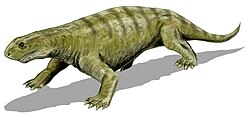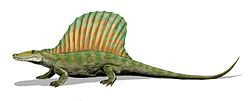| Alierasaurus Temporal range: early Middle Permian [1] | |
|---|---|
 | |
| Reconstruction of Alierasaurus by Emiliano Troco. | |
| Scientific classification | |
| Kingdom: | Animalia |
| Phylum: | Chordata |
| Clade: | Synapsida |
| Clade: | † Caseasauria |
| Family: | † Caseidae |
| Genus: | † Alierasaurus Romano and Nicosia, 2014 |
| Species: | †A. ronchii |
| Binomial name | |
| †Alierasaurus ronchii Romano and Nicosia, 2014 | |
Alierasaurus is an extinct genus of caseid synapsid that lived during the early Middle Permian (Roadian) [1] in what is now Sardinia. [2] It is represented by a single species, the type species Alierasaurus ronchii. Known from a very large partial skeleton found within the Cala del Vino Formation, Alierasaurus is one of the largest known caseids. It closely resembles Cotylorhynchus , another giant caseid from the San Angelo Formation in Texas. The dimensions of the preserved foot elements and caudal vertebrae suggest an estimated total length of about 6 or 7 m (20 or 23 ft) for Alierasaurus. [3] [4] [5] In fact, the only anatomical features that differ between Alierasaurus and Cotylorhynchus are found in the bones of the feet; Alierasaurus has a longer and thinner fourth metatarsal and it has ungual bones at the tips of the toes that are pointed and claw-like rather than flattened as in other caseids. Alierasaurus and Cotylorhynchus both have very wide, barrel-shaped rib cages indicating that they were herbivores that fed primarily on high-fiber plant material. [3]











